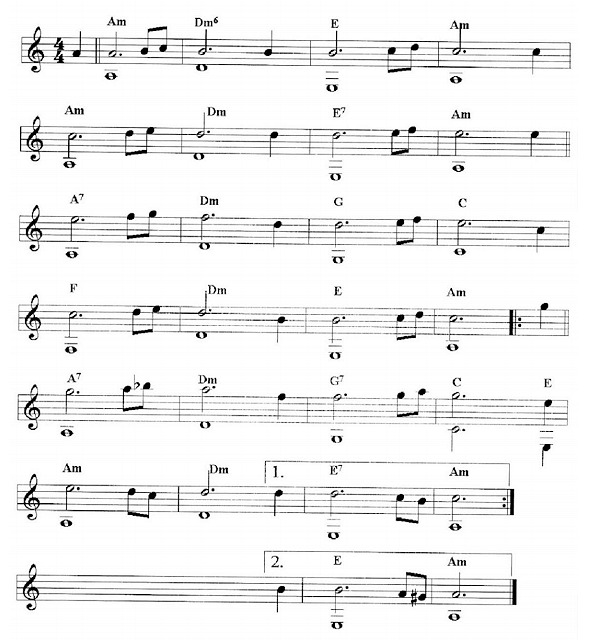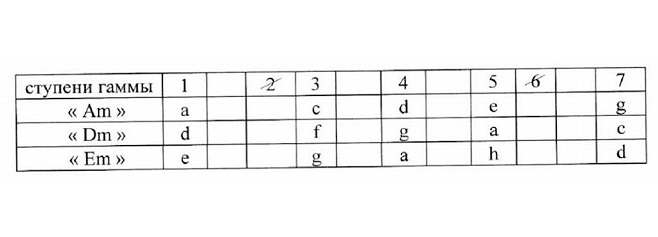
Бесплатный фрагмент - Chords. Golden steps of harmony. Part 3 of 3
Self-study guide to music theory for all instruments

Machine translation from Russian
Mikheyev Sergei Alekseevich
Chords. Golden steps of harmony
Part 3 of 3
Self-study Guide to Music Theory for all instruments
End
(The author has the right to all materials in the book.)
Table of Contents for Part 3 of 3
SECTION 5. COMPOSITION
Chapter 1. Composition.
Notes: Learn to compose.
Chapter 2. Improvisation.
Pentatonic scale.
Notes: Improvisation exercises.
Duet on Spanish motives.
Flight over the mountains.
Sea (song).
Fourth satellite.
Letter.
Chapter 3. Arrangement.
Notes: Guitar ringing.
Recollection.
Arrangement for a group:
Notes: Electronic aquarium.
Spring.
Another world.
Comet flight (with Mechanical improvisation)
Working with the Colored insert.
COLORED INSERT
I. Universal Quart table of chords and keys.
Three quart chord tables for G//Em, C//Am, F//Dm.
II. Quart chord table with notes for the keys of C//Am.
Harmony moves in C//Am.
III. Quart chord table with notes for the keys of F//Dm.
Harmony moves in symbols.
IV. Quart chord table with notes for the keys of G//Em.
Harmony moves in G//Em.
This is where part 3 ends.

Section 5. Composition

Chapter 1. Essay
MELODY
Let’s try to compose a small simple musical piece. There will be a melody and harmony. Let’s imagine the notes of the «Am» scale as numbers: 1, 2, 3, 4, 5, 6, 7, 8. Let’s try to draw patterns from numbers, using numbers for a simplified scheme. This is our first experience in composing. There will be nothing strange in the fact that this will be a very simple melody. Let’s take the first step on a long path and come up with such a pattern:
1) 1 — 1 — 2 — 3 — 2
Ordinary people try to sound each invented part on some instrument. To hear if it sounds nice. But great musicians can do with notes alone without sound. Today we will allow ourselves to be great musicians. — Composing without sound.
So, we got a small piece of melody. We will add to it piece by piece. Each time we will add one to each digit of the previous piece.
Let’s make the pattern repeat four times. This is all optional. But here we will make sure that to begin with, the last note in the fourth pattern would fall on one of the notes of the tonic chords. Mainly minor Am. Then you can major C.
2) 2 — 2 — 3 — 4 — 3,
3) 3 — 3 — 4 — 5 — 4,
4) 4 — 4 — 5 — 6 — 5.
5) 5 — 5 — 6 — 7 — 6,
We went up — now we go down the ready steps.
6) 4 — 4 — 5 — 6 — 5,
7) 3 — 3 — 4 — 5 — 4,
8) 2 — 2 — 3 — 4 — 3.
The repeating pattern gave our music integrity. But you can’t repeat the same thing for too long. It will be boring, dull, uninteresting. Therefore, «expectancy» must be combined with surprise. To make a melody unexpected, new, interesting — you need to come up with something bold and original. Well, at least a little. Leaving the same pattern for now, let’s shift it sharply up. Then another step down.
9) 7 — 7 — 8 — 9 — 8,
10) 6 — 6 — 7 — 8 — 7
We are approaching the end. We will not repeat the same thing. But we will not stray far from the original pattern. Let’s go further down — but we’ll mirror the pattern horizontally.
11) 5 — 5 — 4 — 3 — 4,
12) 4 — 4 — 3 — 2 — 3
Let’s make it so that everyone has less work to do and the music lasts longer. Everyone does it. Let’s repeat the last eight bars because of the bar. But the previous ending was (and intentionally) made with a feeling of incompleteness and readiness to continue. Simply put, the ending did not bring the melody to the tonic. After the repetition, instead of the pattern 12, we’ll make a new pattern ending on the minor tonic. (-1) here means a note lower than 1.
13) 2 — 2 — 1 — (-1) — 1.
HARMONY
To begin with, let’s roughly, not exactly, imagine what chords we’ll have. Let’s take move 2 from the Table of Harmony Moves: Т — С — Д — Т. Mainly adhering to this move, somewhere we will partially take move 3: Т — С — Д — Т. In black text they look the same. And in color move 2 consists only of blue chords of the minor series. Move 3 only of red, from the major series. Now we have approximately, not exactly, imagined what the harmony will be.

RHYTHM
We won’t complicate things now. We’ll just take the 4/4 time signature. Of course, you can take any other. For example, 12/8 is a good time signature. We’ll try to make sure that one chord falls on one bar. We’ll come up with a rhythmic pattern for the melody. Something like Tam tapa — tam, Tatam tapa — tam. We’ll see it in the notes in the future. And for simplicity, we’ll repeat this rhythmic pattern.
ADDING LOCAL SIGNS
When composing, we look for a beautiful harmony, then a melody. In some places we do it this way, in others — that way. If we like the melody more, we adjust the harmony to it. That is, we look for moves and chords that would suit the strong notes of the melody. And if we like the harmony more, we adjust the melody to it.
This is where local (non-key) signs appear. But here we have talked about strong notes included in chords. As for weak notes not included in chords — this is already the composer’s business. If we like, we can put them wherever we want.
Note that there are two notes here that are outside the scale. These are 9 and (- 1). The minus one will have to be brought closer to the scale with a sharp — it is as if attracted by 1, the tonic. And so in the future we will have to do this often, adjusting the minus one to the chord E. (This is not necessary.)
We pulled the only note that went down, with a sharp close to the scale. Well, from a sense of symmetry and for originality, we will pull the nine close to the scale with a flat. This is B — flat. This is rarely done — but it sounds impressive. The melody here is as if attracted by the keys from the lower band «F» // «Dm».
COMPLETION OF THE COMPOSITION
It remains to put the finishing touches on our musical picture. To make it a little more original and interesting. At the beginning of the fourth line of notes, we will change the chord Am to F. This is move 7 in the Table. The note c sounds rhythmically strong there. It can be included in the chord Am and F, so F will easily fit.
Here we saw the attraction of the lower pair of keys. It happens that the melody with harmony is drawn out by the upper pair of keys. And at the end of the fifth line of notes, we will put a very short-sounding chord E. For tension before the music calms down and ends. And there you have it! Well, the beginning has been made. It’s time to give a name to our composition. Let’s call it «Learn to compose.» Look at the notes, perform and listen. It sounds beautiful!

LEARN TO COMPOSE

And if you also add one, two, three (as many as you can) notes from the chord to the bass, and play this «arpeggio» (picking) — then you will get a pretty good thing, I assure you.
Chapter 2. Improvisation
Remember that there was a chapter called «Composition» before. Improvisation is composition, only right now, on the go, when the performer simultaneously composes and plays what he has composed.

If you improvise alone, you are, of course, free to choose the harmony at any moment of the performance. However, it is difficult to play improvisations alone, and they sound somewhat poor. It is better to improvise to some background. With a partner or with a group, or to a recording.
IMPROVISATION PLAN
You can do it like this. The main thing is to take a beautiful series of chords, not too long. So that it can be remembered (sometimes you can write it down and put it in front of the performers). And then these chords are played by a partner (group) while you are improvising. You can agree that someone will give a prearranged signal that the improvisation is ending.
You can make several parts: introduction, bridge, insertion (somewhere in the middle), conclusion. Moreover, these parts should be on other chords and performed in a slightly different style than the rest of the improvisation. — They can be composed and learned in advance, although this is not necessary. It will be better if everyone gets a piece of paper on which the general plan and their personal part are written. Not necessarily in detail.
Of course, if you have a good group, you can improvise not only with someone else, but simultaneously or in turns. But even if the group consists of musicians who are not very skilled — there is still room for their imagination in performing rhythm, bass and chords. And someone can sometimes insert a simple melody composed in advance. You can improvise with your voice. In general, the better you want to make the improvisation, the more you will have to think.
EXAMPLE. Improvisation plan in «Am».
1. Introduction.
Chords: / Am / C // — repeat 4 times.
The bass repeats a simple melody: a — a h c — c h a…
2. Part.
/ Am / Dm / E / Am E // — many times.
The solo does everything it can. And when it can’t, it plays one or two notes per bar or is silent altogether. When it seems that it’s time to move on to the next point, the solo gives a prearranged signal: it plays one note a… for all the chords.
3. Insertion.
/ F B / E Am / B E / Am //- a few times.
Solo. You can feel free to play long, rare notes.
The bass repeats the basses — fast notes several times each.
Someone gives a prearranged signal to move on to the next point.
4. Part as before, point 2.
5. Conclusion.
Like the introduction, point 1. But with a slower tempo towards the end. You can add something unusual. For example, a special play of two instruments in combination. It can be bass and solo, or bass and drums, or bass and chords. The bass can repeat one note on both chords — a. End on the chord Am.
RHYTHMICS IN IMPROVISATION
Modern music uses improvisations with syncopated rhythm. Rhythmics in improvisation are no less important than melody. This is how the process of improvisation looks like: having harmony (specific chords), you come up with notes of the melody. Imagining their future sound rather vaguely and approximately. But you should imagine the rhythmic pattern in advance accurately, clearly and without mistakes.
It may not be so important whether you play this note, or that one, or the third one. But it is very important that if you imagine 1/8, it would be exactly 1/8, and not 1/7 or 1/9. If you have come up with beautiful notes of a melody, but have not been able to perform them beautifully and correctly rhythmically — improvisation is lost!
But if you have played a beautiful rhythmic pattern, and in the melody you have come up with at least did not go beyond the key and chord — improvisation will not be spoiled. Although melodically, it may not be very good.
As exercises in rhythm in improvisation, you can, for example, simply tap your fingers on the table, composing rhythms.
HARMONY IN IMPROVISATION
When inventing chord rows for improvisation, do not go to extremes. On the one hand, do not get carried away with short rows, where all the chords sound exactly on the beat. — Then improvisation will be monotonous, monotonous and boring. On the other hand, avoid overly complex rows. — So as not to get confused in the chords during the game.
MELODICA IN IMPROVISATION. PENTATONICS
Here we can recommend the following. Improvisations built from the notes of the pentatonic scale sound beautiful and stylish, but somewhat simplified. And to get rid of the feeling of simplification, you need to use more introductions, plays, inserts and conclusions. In which you can abandon the principle of the pentatonic scale.
Pentatonic scale means «five — sound». These are five magic notes from the scale, which always give good improvisation and a good melody.
— Provided that they do not sound too long. You can’t always use only them — because it sounds too monotonous. These five notes are selected from minor scales like this:

That is, they take the scale and remove the 2nd and 6th steps from it. In this table — three pentatonic scales for three keys. Of course, the melody is not limited to one octave. But we practically ignore the chords here. — Which makes life nice and easy! If you use the Pentatonic scale — try not to go beyond it. Usually finish on the tonic note.
Can be used in improvisation:
1) only pentatonic notes;
2) pentatonic notes plus sometimes, for variety, scale notes;
3) sliding notes between pentatonic notes. For example, e — eb — d. You can do it once. Or several times. In one or two places. Or with a movement far up or down. It looks impressive when it is performed quickly. You can risk just quickly playing all the notes in a row by tones, without thinking about which ones. If on a guitar, then we move from string to string. Start with a note and end with a pentatonic note.
If you have a guitar, then you will inevitably have to use the principle of Mechanical improvisation according to diagrams. For A minor, these diagrams are given in the Self-study Guide for Guitar — after the chord diagrams. And for E minor — in this book after the notes «Comet’s Flight». It is better to use thin strings more often. And it is better to play less — but correctly. Forward!

IMPROVISATION EXERCISES
1. (Pentatonic scale).

2. (Pentatonic scale).

Бесплатный фрагмент закончился.
Купите книгу, чтобы продолжить чтение.
